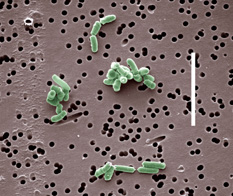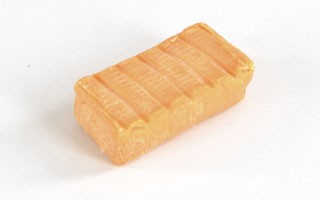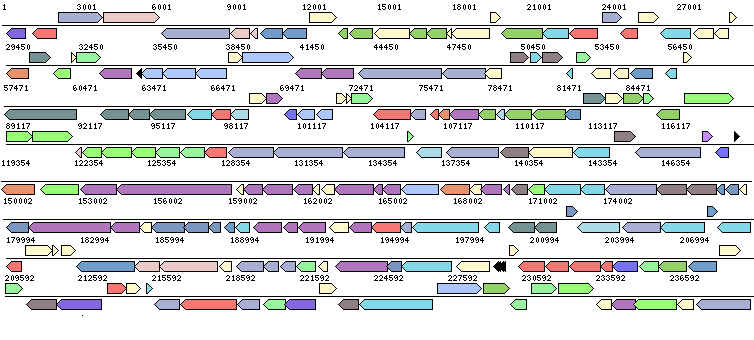Brevibacterium linens: Difference between revisions
No edit summary |
|||
| (9 intermediate revisions by 2 users not shown) | |||
| Line 5: | Line 5: | ||
===Higher order taxa=== | ===Higher order taxa=== | ||
Bacteria; Actinobacteria; Actinobacteria; Actinobacteridae; Actinomycetales; Micrococcineae; Brevibacteriaceae; Brevibacterium <sup> | Bacteria; Actinobacteria; Actinobacteria; Actinobacteridae; Actinomycetales; Micrococcineae; Brevibacteriaceae; Brevibacterium <sup>[2]</sup> | ||
[[File:Brevibacteriumlinens.jpg| | [[File:Brevibacteriumlinens.jpg|800px|thumb|right|Structure of ''linens''<sup>[5]</sup>]] | ||
===Species=== | ===Species=== | ||
| Line 12: | Line 12: | ||
''Brevibacterium linens'' | ''Brevibacterium linens'' | ||
==Description and significance== | ==Description and significance== | ||
[[File:Romadur.jpg| | [[File:Romadur.jpg|600px|thumb|left|Romadur cheese <sup>[6]</sup>]] | ||
''Brevibacterium linens'' is found in soil but what makes it unique to other ''Brevibacterium'' is that it is also found on human skin, more specifically our feet <sup>4</sup>. It causes foot odor. | ''B.linens'' cell wall contains teichoic acids which have neutral sugars, amino sugars, and sugar alcohols. This provides support to the cell wall<sup>[1]</sup>. It is heterogeneous and consists of at least 2 DNA-DNA homology groups. It grows well on peptone-yeast extract media. In order to see the color pigment of ''B.linens'' at some point the media needs to be exposed to light<sup>[1]</sup>. | ||
''Brevibacterium linens'' is found in soil but what makes it unique to other ''Brevibacterium'' is that it is also found on human skin, more specifically our feet <sup>[4]</sup>. It causes foot odor. | |||
Another thing that makes it unique is that it is found in cheeses. It was first isolated from romadur cheese in Germany<sup>[4]</sup>. Other cheese surfaces it is on are Munster, Brick, Tilsiter, and Appenzeller<sup>[3]</sup>. | |||
| Line 31: | Line 42: | ||
[[File:Linensgenome.png]] | [[File:Linensgenome.png]] | ||
''Brevibacterium linens'' has a linear genome with 4,366,969 base pairs. There are 2,741,031 G+C base pairs, making up 63% of the genome<sup>4</sup>. The picture above shows a partial sequence of the genome. Each color represents different types of | ''Brevibacterium linens'' has a linear genome with 4,366,969 base pairs. There are 2,741,031 G+C base pairs, making up 63% of the genome<sup>[4]</sup>. The picture above shows a partial sequence of the genome. Each color represents different types of transport genes and the direction of gene sequence on the genome <sup>[4]</sup>. | ||
==Cell and colony structure== | ==Cell and colony structure== | ||
''Brevibacterium linens'' are gram positive, rod-shaped colonies <sup>4</sup>. When looking under the microscope it exhibits a rod | ''Brevibacterium linens'' are gram positive, rod-shaped colonies <sup>[4]</sup>. When looking under the microscope it exhibits a rod coccus shape on the media but as the cells enter stationary phase they become coccoid shaped <sup>[3]</sup>. Both of these shapes are gram positive but some of the strains can decolorize easily <sup>[3]</sup>. They are non-motile and aerobic. These colonies have a pH range of 5.5-9.5. It is halo-tolerant and non sporing. | ||
==Metabolism== | ==Metabolism== | ||
''Brevibacterium linens'' is | ''Brevibacterium linens'' is obligately aerobic. It is catalase positive and oxidative towards sugars. It is able to hyrdolyze casein, gelatin, and milk<sup>[1]</sup>. | ||
''B.linens'' plays a big role in the metabolism of cheeses. The ripening of the cheese goes from a yeast and mold flora to a bacterial flora <sup>[3]</sup>. The yeast uses the lactate in the curd for energy, increasing the pH, allowing growth of ''B.linens''. These cheeses are high in salt concentration with allows only halotolerant microorganisms to grow on the surface of the cheese<sup>[3]</sup>. | |||
==Ecology== | ==Ecology== | ||
''Brevibacterium linens'' does not have any endospore formation and is nonmotile. The temperature range is mesophilic, however the optimum temperature for growth is 20-30°C <sup>4</sup>. | ''Brevibacterium linens'' does not have any endospore formation and is nonmotile. The temperature range is mesophilic, however the optimum temperature for growth is 20-30°C <sup>[4]</sup>. It is found in places with high salt concentration. | ||
There have been some isolations of ''Brevibacterium'' from marine fish and sea water that seem to be an orange pigment strain that is considered to be very similiar to ''B.linens''<sup>[1]</sup>. | |||
==Pathology== | ==Pathology== | ||
There are no known pathogens with this bacteria. | There are no known pathogens with this bacteria, however there are some known pathogens with different species in the genus ''Brevibacterium''<sup>[1]</sup>. | ||
==References== | ==References== | ||
[1] | [1] Collins, Matthew. "The Genus ''Brevibacterium''". ''Prokaryotes'', Volume 3, 2006, pages 1013-1019. | ||
[2] Rattray, Fergal P., and Patrick F. Fox. "Aspects of Enzymology and Biochemical Properties of Brevibacterium Linens Relevant to Cheese Ripening." Journal of Dairy Science, Volume 82, 1999, Pages 891-909. | [2] NCBI. U.S. National Library of Medicine. <http://www.ncbi.nlm.nih.gov/> | ||
[3] Rattray, Fergal P., and Patrick F. Fox. "Aspects of Enzymology and Biochemical Properties of Brevibacterium Linens Relevant to Cheese Ripening." ''Journal of Dairy Science'', Volume 82, 1999, Pages 891-909. | |||
[4] JGI. DOE Joint Genome Institute. <http://img.jgi.doe.gov/cgi-bin/w/main.cgi?section=TaxonDetail&taxon_oid=638341022#> | [4] JGI. DOE Joint Genome Institute. <http://img.jgi.doe.gov/cgi-bin/w/main.cgi?section=TaxonDetail&taxon_oid=638341022#> | ||
Latest revision as of 02:25, 18 May 2013
A Microbial Biorealm page on the genus Brevibacterium linens
Classification
Higher order taxa
Bacteria; Actinobacteria; Actinobacteria; Actinobacteridae; Actinomycetales; Micrococcineae; Brevibacteriaceae; Brevibacterium [2]
Species
Species (linens)
Brevibacterium linens
Description and significance
B.linens cell wall contains teichoic acids which have neutral sugars, amino sugars, and sugar alcohols. This provides support to the cell wall[1]. It is heterogeneous and consists of at least 2 DNA-DNA homology groups. It grows well on peptone-yeast extract media. In order to see the color pigment of B.linens at some point the media needs to be exposed to light[1].
Brevibacterium linens is found in soil but what makes it unique to other Brevibacterium is that it is also found on human skin, more specifically our feet [4]. It causes foot odor.
Another thing that makes it unique is that it is found in cheeses. It was first isolated from romadur cheese in Germany[4]. Other cheese surfaces it is on are Munster, Brick, Tilsiter, and Appenzeller[3].
Genome structure
Brevibacterium linens has a linear genome with 4,366,969 base pairs. There are 2,741,031 G+C base pairs, making up 63% of the genome[4]. The picture above shows a partial sequence of the genome. Each color represents different types of transport genes and the direction of gene sequence on the genome [4].
Cell and colony structure
Brevibacterium linens are gram positive, rod-shaped colonies [4]. When looking under the microscope it exhibits a rod coccus shape on the media but as the cells enter stationary phase they become coccoid shaped [3]. Both of these shapes are gram positive but some of the strains can decolorize easily [3]. They are non-motile and aerobic. These colonies have a pH range of 5.5-9.5. It is halo-tolerant and non sporing.
Metabolism
Brevibacterium linens is obligately aerobic. It is catalase positive and oxidative towards sugars. It is able to hyrdolyze casein, gelatin, and milk[1].
B.linens plays a big role in the metabolism of cheeses. The ripening of the cheese goes from a yeast and mold flora to a bacterial flora [3]. The yeast uses the lactate in the curd for energy, increasing the pH, allowing growth of B.linens. These cheeses are high in salt concentration with allows only halotolerant microorganisms to grow on the surface of the cheese[3].
Ecology
Brevibacterium linens does not have any endospore formation and is nonmotile. The temperature range is mesophilic, however the optimum temperature for growth is 20-30°C [4]. It is found in places with high salt concentration.
There have been some isolations of Brevibacterium from marine fish and sea water that seem to be an orange pigment strain that is considered to be very similiar to B.linens[1].
Pathology
There are no known pathogens with this bacteria, however there are some known pathogens with different species in the genus Brevibacterium[1].
References
[1] Collins, Matthew. "The Genus Brevibacterium". Prokaryotes, Volume 3, 2006, pages 1013-1019.
[2] NCBI. U.S. National Library of Medicine. <http://www.ncbi.nlm.nih.gov/>
[3] Rattray, Fergal P., and Patrick F. Fox. "Aspects of Enzymology and Biochemical Properties of Brevibacterium Linens Relevant to Cheese Ripening." Journal of Dairy Science, Volume 82, 1999, Pages 891-909.
[4] JGI. DOE Joint Genome Institute. <http://img.jgi.doe.gov/cgi-bin/w/main.cgi?section=TaxonDetail&taxon_oid=638341022#>
[5]Leary, Heather. The Microscopy Facility. <http://bioweb.usu.edu/microscopy/Research.htm>
[6]The refined world of cheese. <http://pro-cheese.ru/romadur.html>
Edited by Brittany Harlow, student of Dr. Lisa R. Moore, University of Southern Maine, Department of Biological Sciences, http://www.usm.maine.edu/bio



